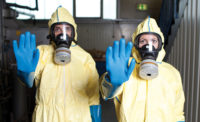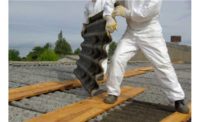A new study summarizing exposures to asbestos during the installation and removal of asbestos cement products demonstrates that these construction activities almost always exceed U.S. occupational limits. The study focused on airborne asbestos exposures from existing uses of asbestos that are still allowed in most countries.
Average task-specific asbestos exposures during the cutting of asbestos cement pipe were more than 50 times the Occupational Safety and Health Administration (OSHA) short-term limit. Cutting asbestos boards and corrugated roofing result in average exposures that are 24 times the limit.
Asbestos cement products including pipe, siding and roofing account for more than 90% of global asbestos use.
“We found that exposures from asbestos cement products could be alarming high and certainly disproves the asbestos industry’s contention that these materials can be used in a ‘safe and responsible’ manner” said Perry Gottesfeld, Executive Director of Occupational Knowledge International (OK International) and the author of the study.
“The study demonstrates that there is an immediate need to ban all asbestos cement products that are sold in many countries as these are still being installed in millions of homes and commercial buildings,” Gottesfeld added.
The study Exposure Hazards from Continuing Use and Removal of Asbestos Cement Products published online in the Annals of Work Exposures and Health, documents that all uses of asbestos cement pipe and the great majority of installation tasks for asbestos cement roofing and sheets exceed the current OSHA short-term exposure limit. The results also indicate that the use of water to reduce airborne fibers is insufficient to protect workers during most tasks involving power tools.
Although more than 60 countries have banned the use of asbestos, the U.S. Environmental Protection Agency (EPA) is only now considering a total ban on asbestos cement and other existing uses. Currently, the EPA only requires companies to notify the agency before manufacturing or importing asbestos cement products.
Russia and Kazakhstan account for 80% of global asbestos production and they export this material to more than 25 low and middle-income countries. India, China, Indonesia, Uzbekistan, Sri Lanka, Vietnam and Thailand are the largest importers and account for approximately 90% of global asbestos sales.
In 2021 more than 1.2 million metric tons of asbestos was mined primarily for asbestos cement applications. Russia is by far the largest beneficiary of this hazardous trade, earning $185 million in 2021.
Thousands of workers are exposed to airborne fibers during the manufacture of asbestos cement products in hundreds of small factories in India, Vietnam and other countries. Tens of thousands of construction workers are exposed to airborne asbestos in excess of the short-term OSHA excursion limit while installing asbestos cement roofing, siding, cooling towers and pipes.
Even intermittent short-term exposures to asbestos are associated with significant health risks. Asbestos has been shown to cause lung cancer, asbestosis and mesothelioma.
The U.S. has approximately 600,000 miles of ageing asbestos water pipe with a typical lifespan of 50 years. Water utilities are often replacing asbestos water main sections as pipes burst or as part of ongoing systems improvements.
In many countries older asbestos-cement pipe and roofing are reaching the end of their service life and will need to be removed while creating hazardous conditions for workers while cutting and breaking up this material. Few countries have occupational limits or other safety regulations governing procedures for asbestos abatement.
OK International is a U.S. based NGO that works to build capacity in developing countries to identify, monitor, and mitigate environmental and occupational exposures to hazardous materials in order to protect public health and the environment. For more information: www.okinternational.org





